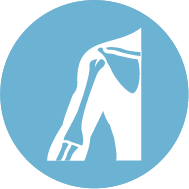
A dislocation of the shoulder usually refers to the ball and socket (glenohumeral) joint part of the shoulder being injured. This is different from an AC joint dislocation, which is the small joint between the collarbone (clavicle) and the shoulder blade (scapula) on the top of the shoulder.
A glenohumeral joint dislocation can occur during a fall, or in a sporting collision where the arm is twisted at an awkward angle or it receives a direct blow. The ball usually slips off the front of the socket, and in doing so it damages the ligaments and joint capsule at the front of the shoulder. As the ball recoils back and hits the front of the socket, a dent can be left in the back of the ball. This dent is called a Hill-Sachs lesion.
In patients that are older than 40, the labrum may not be injured but may instead sustain a tear in one or more of the rotator cuff tendons. These tendons surround the humeral head and help to keep it stable during elbow movement. A rotator cuff tear can lead to weakness or pain when trying to elevate the affected arm.
Once a person has sustained a dislocated shoulder they have a higher risk of it happening again. The two most important factors for determining the risk of recurrence are young age and high activity levels. Recurrent instability can lead to problems with the affected arm in an overhead position because it feels weak or unstable (or both). In addition, recurrent episodes in glenohumeral dislocations will increase the risk of developing shoulder arthritis.
There are several surgical procedures available to manage shoulder instability. These include arthroscopic stabilisation, the Latarjet procedure and SLAP repair.
Surgery on its own can greatly improve the stability of your shoulder but it does not make it normal. After the surgery, you will need to undergo a prolonged course of rehabilitation, supervised by your physiotherapist. This is in order to improve the strength and control of the small muscles (dynamic stabilisers) that help to keep the ball connected to the socket.